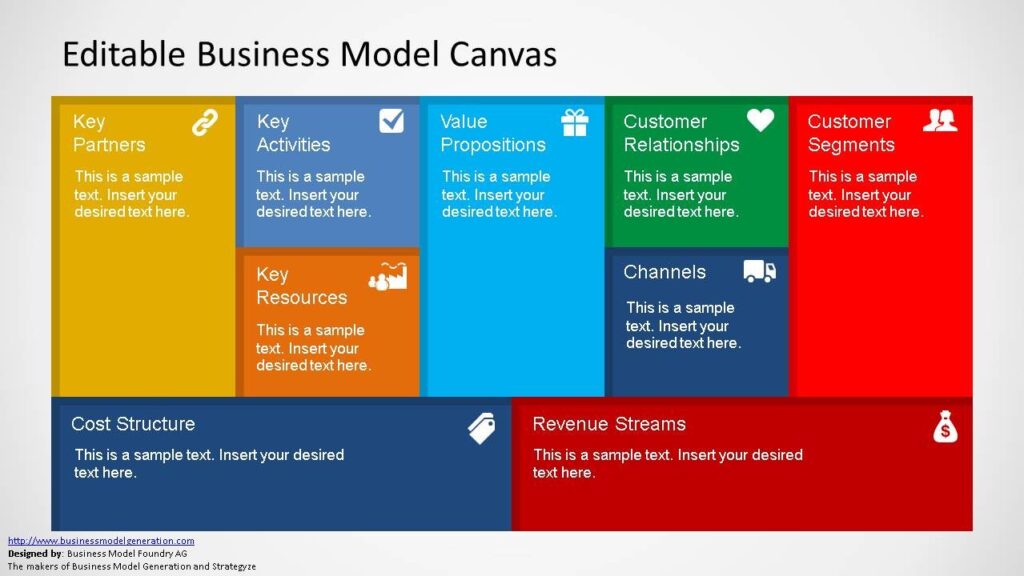Understanding how SEO and content marketing services fit into a digital agency’s Business Model Canvas is key to long-term success. These services help attract new customers by making websites more visible on search engines and providing useful content people want to read. Inside the canvas, they fall under both “Key Activities” and “Value Proposition” because they bring real results for clients. Whether it’s writing blog posts, improving keywords, or sharing helpful guides, SEO and content marketing give agencies a powerful way to stand out. They also build trust, increase traffic, and help clients grow online in a smart and steady way.
What Is a Business Model Canvas?
A business model helps you understand how a company makes money, delivers value, and keeps customers happy. For those new to the topic, this definition of a business model from Investopedia explains it clearly. The Business Model Canvas takes this idea and turns it into a simple one-page plan that anyone can use, even without a business degree.
Customer Segments – Understanding the Clients
The first part of the canvas is about knowing who the business helps. A digital marketing agency must know who its clients are. Some agencies work with small businesses. Others focus on online stores, real estate offices, medical clinics, or local service providers. Every group of clients has different needs. When an agency picks one or two groups to focus on, it becomes easier to create useful services for them. For example, a digital agency may work only with beauty salons or restaurants. This helps the agency talk clearly to its ideal customers and understand them better.
Value Proposition – What the Agency Offers
The value proposition shows what the agency promises to deliver to its clients. This is about solving a problem or helping the client reach a goal. For example, a client might want more website visitors, more phone calls, or better social media results. The agency must give something valuable in return for the client’s trust and money. Some agencies offer help with running ads, writing blog posts, or improving search engine rankings. Others help with email campaigns, social media management, or branding. Whatever the service is, it should clearly help the client succeed online. A good value proposition shows how the agency is different from others and why clients should choose it.
Channels – How the Agency Reaches Clients
Every business needs a way to connect with its audience. In a digital marketing agency, these are called channels. Channels are how the agency talks to people, delivers services, and stays in touch. Many agencies use their own websites, social media accounts, and emails to find new clients. Others use paid ads, cold emails, or phone calls to get leads. Blogs are also a helpful channel for sharing useful tips and showing skills. The most successful agencies choose the right channels based on where their clients spend time. If the clients are on Instagram or LinkedIn, then the agency should focus more on those places. Clear and smart use of channels brings in more business.
Customer Relationships – Keeping Clients Happy
Once the agency has clients, it must take care of them. Building strong customer relationships is very important. Happy clients return with more work and also tell others about the agency. Good communication is the key to a healthy relationship. Many agencies talk to their clients weekly or monthly. They give reports to show results. They listen to feedback, make changes, and answer questions fast. Some agencies use WhatsApp, Zoom, or Google Meet to stay connected. When clients feel respected and supported, they stay longer. That’s why great service is just as important as good marketing skills.
Revenue Streams – How the Agency Makes Money
An agency must earn money to stay open and grow. Revenue streams are the ways the agency gets paid. Some agencies charge clients monthly, while others earn from one-time projects. Many offer packages that include SEO, paid ads, and content writing. Others take a percentage from the client’s ad budget. Some agencies even sell eBooks, training programs, or marketing tools. Having more than one way to make money can keep the agency safe during slow times. A steady stream of income helps the business grow stronger every month.
Key Resources – What the Agency Needs to Work
Every business needs some tools and people to keep things going. These are called key resources. A digital marketing agency needs good team members, such as marketers, writers, and designers. It also needs powerful software tools to do SEO, run ads, and manage content. A clean and working website is another important resource. Reliable internet, computers, and workspaces help the team get things done. Some agencies also use customer management tools to stay organized. All these resources help the agency do its job well and keep clients happy.
Key Activities – What the Agency Does Daily
To succeed, an agency must do certain tasks every day. These tasks are called key activities. Writing blog posts, creating social media content, running ad campaigns, and checking how things are performing are just a few examples. Keyword research is also an important activity for SEO. Some agencies design websites or landing pages. Others track how many people clicked an ad or signed up for an offer. By doing the right activities daily, the agency gets better results for clients. And when clients are happy with the results, they trust the agency more.
Key Partnerships – Who Supports the Agency
Running an agency alone can be hard. Many agencies work with partners who help them. These can be freelancers, like graphic designers or video editors. Others work with software companies that provide tools. Some agencies team up with influencers or affiliate partners to get more reach. Having strong partnerships can save time, improve service quality, and offer new ideas. Good partners help the agency grow faster and serve clients better.
Cost Structure – What the Agency Spends Money On
Every business has costs. The cost structure explains where the money goes. A digital marketing agency usually spends money on team salaries, freelancer fees, and software tools. It also pays for website hosting, ads, and office space if needed. Some agencies invest in online learning or training for their team. Knowing the cost structure helps the agency set prices that cover costs and make a profit. Keeping track of spending is important for success.
Real-Life Example of a Digital Marketing Business Model
Let’s imagine a small agency called FastGrow Digital. This agency works mostly with local service providers. FastGrow Digital promises to help clients get more phone calls and website visits using Facebook Ads and Google My Business. They talk to clients through email and offer live video calls. Their money comes from monthly service plans and one-time setup fees. To do their job, they use SEO tools, an ad manager, and a content writer. Each day, they run ad campaigns, write posts, and review client data. They work with a local graphic designer and an SEO expert as partners. Their biggest costs are software, salaries, and advertising budgets. By keeping their plan simple, FastGrow Digital grows slowly but surely.
Why Every Agency Should Use the Canvas
The business model canvas helps new and old agencies stay focused. It shows what’s working and what’s not. Instead of guessing, agency owners can look at the canvas and know where to improve. It’s simple, easy to change, and powerful. Whether the agency is just starting or already growing, the canvas brings new clarity. It helps the team make smart choices and serve clients better.
Conclusion – Planning for Success
A business model canvas is more than just a plan. It’s a tool for thinking, growing, and solving problems. It gives a full view of the digital marketing agency’s business in a single page. Every part matters. From understanding customers to earning money and building a strong team, each section plays a role in long-term success. When an agency takes time to fill out this canvas, it makes better decisions and serves people more effectively.
FAQS
1. What is a business model canvas?
A business model canvas is a one-page plan that shows how a business works. It helps digital marketing agencies understand their customers, services, and how they make money.
2. Why is the business model canvas important for digital marketing agencies?
It helps agency owners see all parts of their business in one place. This makes it easier to plan, grow, and improve the agency over time.
3. How can a digital marketing agency use a business model canvas?
An agency can use the canvas to map out its services, target audience, pricing, tools, team members, and more. It acts like a simple guide for daily decisions.
4. What are the 9 sections of the business model canvas?
The nine parts are: customer segments, value proposition, channels, customer relationships, revenue streams, key resources, key activities, key partnerships, and cost structure.
5. What is a value proposition in digital marketing?
A value proposition is the benefit your agency promises to give clients. For example, it could be more traffic, better leads, or stronger online branding.
6. How does a digital marketing agency earn money?
Agencies earn through monthly fees, one-time projects, service packages, ad spend commissions, or selling online products like templates and training.
7. Who can be the target customer for a digital marketing agency?
Target customers can include small business owners, startups, real estate agents, doctors, shop owners, and online stores. It depends on the agency’s focus.
8. What are key activities in a digital marketing agency?
Key activities include running ad campaigns, managing social media, writing content, doing SEO, designing websites, and talking to clients.
9. What are some common costs for digital marketing agencies?
Agencies often spend on software tools, salaries, freelancers, ad budgets, training, websites, and office rent if they have one.
10. Can small agencies use the business model canvas too?
Yes, the canvas works for agencies of all sizes. Small agencies can use it to stay focused and grow faster by making smart, simple choices.









